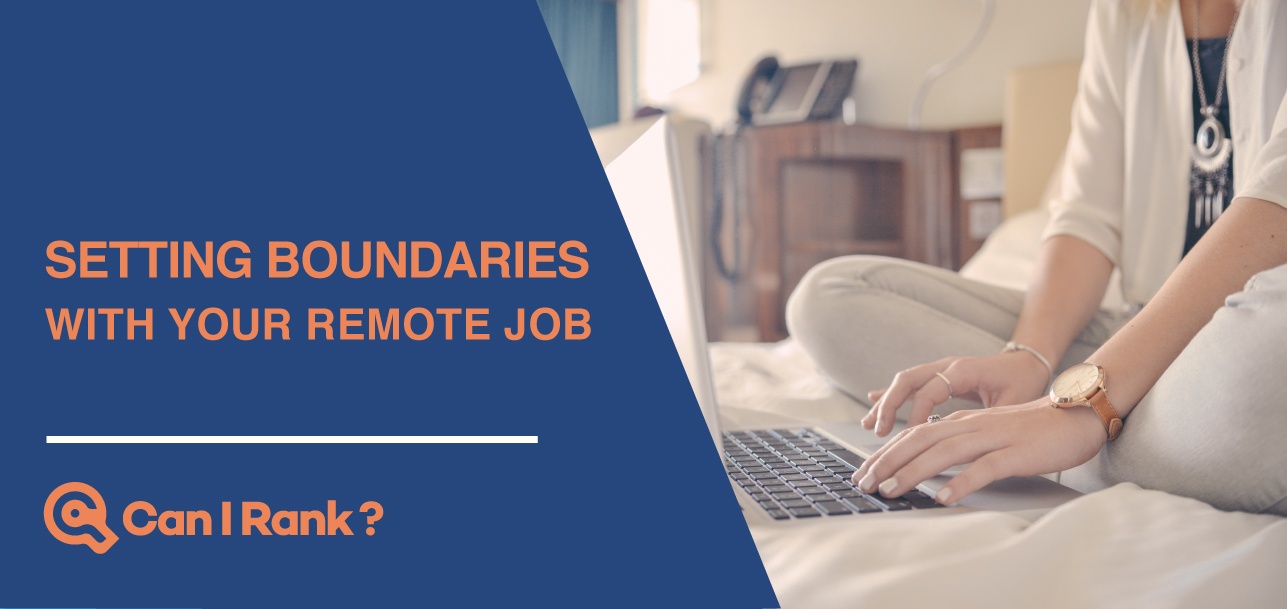The alarm shrills through the otherwise quiet morning. It’s still dark outside, and you must put on uncomfortable, professional clothes and commence your commute to the office.
Or do you?
Nixing this morning routine – and the existential dread that often accompanies it – is just one of the perks of working remotely. Your morning routine is more relaxed. The clothes you wear can focus on comfort over impressing those at the office. No more packing lunch – you can make it fresh in your own kitchen!
If you want a change of scenery, you can work at your favorite cafe – or better yet, start up your car and drive to a new city. Heck, you can even jump on a plane and work from another country if you want!
The world is your office! Well, anywhere in the world with Wi-Fi…
However, just like anything else, remote work can have its drawbacks. Perhaps the most challenging of which is setting boundaries between your life and your job.
Often, you use the same computer for work as you do for everything else. Plus, there is no physical “office” where you can leave, signaling the end of the workday. And if you work in a different time zone from the rest of the team, that often means attending meetings either ridiculously early in the morning or way past your bedtime.
Working remotely can set you free from the monotonous daily grind often associated with office work, but it can also feel as if it is taking over your life if you don’t set clear boundaries.
That’s why we reached out to remote workers both within CanIRank and at other notable businesses to ask how they set those boundaries. This is the first of our new two-part series on remote culture.
John Shieldsmith, SEO and Digital Marketing Consultant, CanIRank
Setting boundaries while working remotely can be incredibly tough. This is especially the case if you don’t have a dedicated workspace.
I have my office space set up in our bedroom, so I have to set a mental boundary more than anything. Further complicating things, I often work from my gaming PC, making the line between work and play all the thinner!
The first boundary I set is with my browser. I have a Chrome window dedicated to working, with all my fun tabs hidden in another window. To make this easier, I use Session Buddy, a plugin that lets you save custom browsing sessions and tabs by name.
I further my boundaries by turning notifications for my work email off on my phone at night. This prevents me from checking it too often. The same goes for Slack. Ideally, I won’t even look at my phone once I’m in bed, but mistakes happen and games must be played sometimes.
Finally, I have certain playlists I usually only listen to when I’m working. Soaring Morning on Google Play comes to mind. I’m all about music, so having playlists I can associate with work and not the other part of my life is huge for me.
Qhubekani Nyathi, Long-form Content Strategist, Wholesome Commerce
Two simple limits have hiked my productivity while working from home.
First, I’ve helped my family and loved ones realize that working from home is still work! Yes, it took some time for them to get it, but when they eventually did, they respected my work times and gave me the space to work.
Another simple but radical tip I use is to switch off my phone and put it in another room *gasp*. Believe you me it works and you won’t die. :) Instead, you’ll get loads of work done. The physical effort to stop working, get up, and go to another room to get your phone and switch it on will act as a powerful deterrent. You’ll stay put, focus better, and be productive.
Sara Davis, VP of Growth, CanIRank
I set boundaries by blocking out specific hours of the day dedicated to work and work alone. I also have a dedicated home office set up which makes it easier to stay productive! I have found that regular routines help me stay productive too – including lots of coffee! :)
Sophie McAulay, Growth & Content Strategist, AND CO from Fiverr
I work remotely from locations all around the world. Since I am often in a new place, for me, it’s important to set boundaries between travel and work. I make sure that I take enough time off in each place to see the city so that I don’t feel guilty about working all the time and not making the most of the place. That allows me to really focus on the days that I am working.
I also try to use coworking spaces or libraries as much as possible to ensure that I have clear distinction between work time and home time. If I do work from home (aka the Airbnb of the month), I sit at a desk (rather than the couch) to create the same distinction. Like one third of remote workers, I still sometimes have trouble shutting down at the end of the day, so I often try to schedule an activity or meeting with a friend around the time I want to stop working.
Katelyn Andrews, SEO and Digital Marketing Consultant, CanIRank
I live in a studio apartment in a small town in the middle of Switzerland. My schedule is awesome because it allows me the flexibility to travel, but living and working in the same small space can be draining after a while.
I create a block schedule with a break in the middle to get out of the house and get some exercise to help keep me focused. I work 3-4 hours in the morning, take a solid 2-hour lunch break, then another 3-4 hours in the afternoon. This helps me prioritizes my work day and get a sufficient disconnect to reboot my energy.
Rob McMackin, Product Designer at Slite
I’ve been working on a design team based in Paris, from South Korea. The eight hour time difference often causes work issues to spill into my evenings. A lot of this can be controlled through disabling Slack and email notifications, but it requires willpower on top of that.
Working from a coworking space, having a separate laptop for work and personal use, and leaving that work laptop in a locker at the end of the day can help you to leave work in work, too.
On the design side, we find a lot of design refinement work can happen asynchronously. And only the exploration side of the work needs to happen in meetings, so the overall number of meetings is reduced, reducing the likelihood I’ll have to stay late.
Alison Haselden, SEO and Digital Marketing Consultant, CanIRank
My entire life pretty much runs on intensive scheduling and lists, so I’ve committed to honoring those schedules whether the activities listed are for work or personal life. Part of that includes actively blocking out times during the day that are “no work periods.”
Just as I would commit to a meeting with teammates or clients on my schedule, I honor the “meeting” time I’ve scheduled for my personal life. I find it’s really beneficial to create that mentality of value around your non-working hours so that you can better resist the urge to work! It also increases my productivity and focus during each respective “meeting” of my day!
Emma Valentiner, Director of Optimizations, CanIRank
Schedules are *much* more flexible when you’re working with a remote team – especially one like ours, where team members are scattered across multiple time zones and continents. Being sure to keep an updated calendar, and setting Slack notifications if you’re stepping away for a few hours, is crucial. You still have a great deal of freedom, but you’re not leaving coworkers in the lurch if they have a question, or need some info from you.
Mark Patchett, VP of Growth Nectar Sleep/DreamCloud Sleep and Founder, The Ecom Academy
I’ve iterated a ton of productivity and boundaries methods over the last four years. By far my favourite is hard limiting the amount of time I can spend by using 90 minute Pomodoros. I force myself to achieve everything I need in a day with no more than four 90 minute poms. As soon as I’m over, I’m done.
From the moment I started this process, something magic happened. I immediately stopped filling my day with “busy” tasks and really focused on the core of what would have an impact. And in order to get the most out of that time, I always write myself this question at the end of each day, “If I could do just one thing tomorrow to have the biggest impact, what would it be”.
That method has by default created powerful boundaries and mega productivity.
Maddie Farris, SEO and Digital Marketing Consultant, CanIRank
Some of the best advice I can offer about maintaining boundaries in remote work life is to stress the importance of intentional communication with people you work with. Most remote workers communicate primarily via email and chat – written communication. This is great in terms of convenience and efficiency, but a personal connection and understanding of people’s personality or sense of humor can be lost.
If an emphasis is put on regular verbal communication it’s much easier to get to know one another on a personal level which can mitigate misunderstandings often caused by “misreadings” of written exchanges. Keep the lines of communication open, and don’t be afraid to have a quick chat over Skype or Slack call. We’re all working remotely, we don’t mind your messy bun or your 3rd day of wear sweatshirt.
Rachel Craig, SEO and Digital Marketing Consultant, CanIRank
Contrary to what is generally recommended for a remote worker, I love regularly changing my ¨office.¨ One day you might find me in a cafe in my neighborhood, the next you might find me in a workspace on the other side of the city. I find this frequent change of scenery works incredibly well for me.
My schedule also changes daily, often determined by meetings I have with colleagues in different time zones. So starting my day in my home office and having evening meetings in a cafe where I can get a renewed wave of productivity is valuable in getting the most from my day.
It’s important to create some separation from the home and interact with other people throughout the working day to maintain a healthy mind in a remote work environment.
Pete Ceran, SEO and Digital Marketing Consultant, CanIRank
I add a calendar event in the CIR Gmail Calendar that just says “Blocked Time – Client Name” and make sure that my computer is set to send alerts 10 minutes before I’m set to start working on that client. I also exit out of all communications that don’t involve that client for the block of time and have an open text doc in the right-most fourth of my screen that just keeps notes regarding that client in one place.
At the end of the week, I take stock of the hours I’m supposed to fill for the month for each client, calculate how many hours a week are remaining, and then adjust the blocked time in CIR Gmail Calendar to stay on track.
Molly Nevins, Lead Content Strategist and SEO Consultant, CanIRank
The biggest challenge for me when it comes to setting boundaries when working remotely is turning work mode off. I have young children who need me to be present to their needs and whom I’d like to connect with each night before bed. But that can be tough when I’m still checking my email at 7 p.m. or sneaking glances at my phone during bath time.
Now, I turn my phone and laptop entirely off and put them away. On days when it’s possible, I build in a buffer between work and home (not so simple when work and home are the same place), something like a walk or a ten minute guided meditation.
Every remote worker has different life circumstances and levels of flexibility, but I think turning work off, no matter what your circumstances, is a skill worth mastering.
Matt Bentley, Founder and CEO, CanIRank
I’ve worked in fast-paced technology companies spanning multiple time zones in both remote companies and traditional corporate offices. “Thanks” to modern communication tools and clients/ colleagues spread across the globe, separating work and life can be a struggle regardless of your actual physical location. The bottom line is that we want to be present and responsive for our family, colleagues, employees, and clients, but there’s only so much time to go around.
In many ways, moving from a colocated corporate office environment to a distributed remote team has actually made it easier to manage that balance. In the corporate office, expectations were that I was 100 percent present during office hours, and at least somewhat responsive outside of office hours, which artificially constrained family and personal time to a very narrow box of evenings and weekends (which even then weren’t “intrusion free”).
Rather than trying to adapt remote, flex-time work to fit that outdated mold of Monday-Friday 9-5, I’ve found it more effective to construct a new schedule that allows a more optimal balance of family and work time.
For example, I have young kids who go to bed early, so rather than working until 5 or 6 p.m. and only seeing them for an hour or two, I break around 3 or 4 p.m. for a couple hours of quality family time while the sun is still out and before everyone becomes hangry/ tired at the end of a long day. Then, after my kids are asleep, I log back on with renewed energy during the quiet evening hours when my night owl brain is buzzing with ideas. I also usually swap a little weekend work time for a half day during the week so that we can enjoy the zoo or beach or parks or run errands without the weekend crowds.
It’s helpful to keep things in context. My wife (who also used to work an “always-on” corporate job) and I are always reminding each other how lucky we are to be able to spend time with our family during the week, be present for our kiddos, help each other out on a moment’s notice, and even just step outside to sunshine and green trees rather than skyscrapers or a corporate office park. Gratitude for the many things we’ve gained by moving to a remote setting makes it much easier to accept the occasional blurring of boundaries without losing the joy of those off moments.




Thank you. Scheduling and keeping to that schedule has been the bane of my small online business. This article gave me a number of ideas and workarounds that I plan to implement.